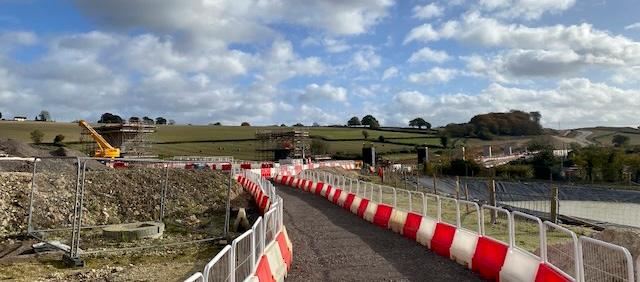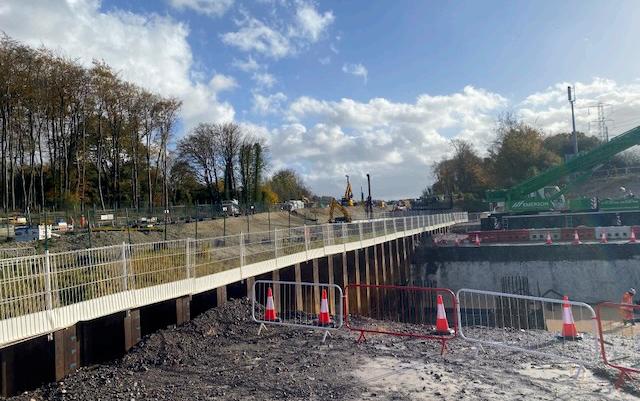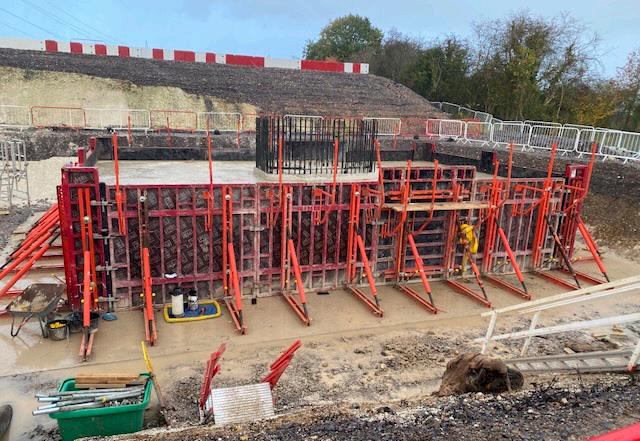
4 minute read
The inside story: Seeing HS2 up close
In mid-November Wendover News was invited by EKFB – HS2’s main contractor on the part of the project going past Wendover – to view progress on the new viaducts. Wendover News volunteer Richard Byford went along. Here is his report on the three-hour tour.


“The first impression, driving into the site from the A413, is the scale and sophistication of the temporary facilities. It’s like entering a different world, far removed from the genteel, picturesque villages so close by. Immediately, the road system seems to be better built than most of the public roadways that I drove along to get there, and a lot wider. There were traffic lights every couple of hundred metres, proper road junctions and road signs. Walkways beside the roads were carefully fenced off to segregate pedestrians from the vehicles. There was even a footbridge to get workers from one side of the site to the other.
The single entrance from the main road between Wendover and Wendover Dean provides a shared point of access to a number of separate compounds – each serving one of the several construction projects along the route. As well as the very conspicuous site for the Wendover Dean viaduct that will span the main road and railway just outside the village, there is another longer and taller one (Small Dean) about a mile further out, which spans a dip on the side of the hill. Three others serve the bridges which will take the railway over the existing roads leading to Ballinger and the area around The Lee.
Huge effort has gone into ensuring that the works are safe. Equal effort has gone into protecting the environment as much as possible, giving that after all it is ripping out a huge scar through the landscape. Paradoxically, this has often needed additional infrastructure. Roads are bowed out to avoid areas when wildlife can’t be moved. Large plastic pipes, gullies and lined ponds abound, to process surface groundwater and catch spillage. Water from large ponds goes through a two-stage filtering process before being released back into the environment. A large truck-wash station sits near the exit onto the public road to ensure that as little mud as possible leaves the site on the tyres of vehicles.
EKFB took the group of invited journalists, including me, to see the 450 metre long Small Dean viaduct being constructed. The nine upright columns are constructed off-site, as sleeve-like components in sections about 2m tall. These are lifted over a complex framework of reinforcing steel protruding from the foundation slabs. These slabs in turn are formed of thick steel-reinforced concrete, several metres deep, poured over the top of four or more piles. These piles are initially bored up to 40m into the chalk of the hill, and themselves are filled with steel-reinforced concrete.
Each of these piles is over 1m in diameter and pins the foundations for the columns to the hillside, ensuring that the viaduct won’t move in any direction. Once the sleeves are in place, concrete is poured over and through the steel reinforcement. The resulting column is capped by a complex structure which holds the beams for the deck along which the trains will eventually run.
All this is a gross simplification of a construction, design and process which requires extraordinary precision, craftsmanship and care. It’s designed to last for at least 120 years of pounding by trains at the original design speed of 400km/hour (250mph). To most eyes they will look as beautiful as any man-made engineering structure could look, in the middle of an area of outstanding natural beauty.
Similar structures are being built alongside the London Road as it leaves Wendover. Here, the challenge is not the hills, but the congested arrangement of a busy main road, a railway and a tangle of underground cables and pipes. EKFB is acutely aware that the people of Wendover don’t want their road or rail closed, their utilities cut off, or their vehicles covered in construction muck as they drive through.
The only way it can do all this is to create temporary ‘wriggle’ in the main road so that it can install each column over a piled foundation. This will need to be done twice to get the two columns closest to the road in place. By about middle of 2025, EKFB hopes this will be finished and the final permanent roadway and a new “greenway” cycle path from Wendover to Great Missenden can be put in. If you would like to view an animation of this, use a smartphone to access a video via the QR code at the top of the next column.
Use this QR code to acceess an animation of the road realignments (wriggles), planned for the London Road just outside Wendover travelling towards Great MIssenden.

The really spectacular part will be when they pull the 6m wide, 2.6m deep box-section main beam of the railway over the road and rail, using complex sliding mechanisms on each column head. Like the Small Dean viaduct, the 350m structure is being built in one piece and will be pulled across the top of the seven columns in a single operation. If that wasn’t impressive enough: It’s being built to go round a slight curve.
How will they construct something that large, make it strong enough to do its job and be capable of being transported as a single structure? While we have been sleeping, EKFB has been sneaking heavy loads of steel and pre-cast concrete into the site without most of us noticing. Vehicles up to 40m long carrying the pre-fabricated steel beams have been transported from France, around the M25 and up the M40 to Beaconsfield and along the A413, between 22:00 and 02:00, without incident. Once offloaded into the assembly area, they are welded together to eventually make up the viaduct main beam. I used the term ‘sneaking’, but EKFB is rather proud of what is being achieved. There just isn’t get much of an audience at that time of night.
If I was reading this, I would be thinking “The person who wrote it is in the pay of HS2” or “I bet they wined and dined him well beforehand.” Well, yes, they plied me with a cup of tea and a double pack of ginger biscuits (I took another pack for lunch when they weren’t looking). I turned down the extravagant Danish pastries. They lent me some splendid bright orange waterproof clothing, helmet, gloves and protective glasses. I got to see an impressive technical slideshow in a lavish office about the size of a portacabin and fitted out with comfortable, if functional, plastic seats.
I was surprised to discover that not all the people I met were unreservedly in favour of the whole HS2 project, including some who work for EKFB. But all were quick to point out that they had an important job to do, were excited, and want to do the very best they can, with as little damage to the environment and landscape as possible.”




